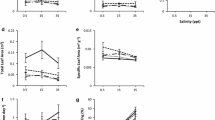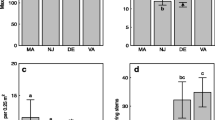Abstract
Ecologists have long speculated that species with wider environmental ranges would have broader ranges in phenotype; however, most tests of this hypothesis have involved small numbers of species and/or closely related taxa. We related phenotypic variation in twelve salt marsh plant species from six families to variation in four environmental variables using multiple regression. Within species, plant phenotype was predictably related to environmental variation. Salinity was the most common predictor of plant traits, followed by organic content, water content and elevation. Across species, regressions of single plant trait CVs on range (2 × SD) of single environmental variables were not significant and did not support the hypothesis that species occupying broad environmental ranges would have broad ranges in phenotypes. However, regression of a composite phenotypic PCA1 on a composite environmental PCA1 showed a marginally significant (P = 0.054). linear relationship for 10 species. Considering the different patterns of response across species, the lack of a relationship between variation in single phenotypic traits and single environmental variables is likely because the distantly-related taxa employed fundamentally different morphological and physiological strategies to respond to environmental stress gradients. The significant relationship between composite environmental and phenotypic variables reflects the complex nature of species phenotypic response to multivariate environmental gradients. Specifically, in this system, species increase variation in the number of leaves, but decrease variation in leaf size in response to an increase in range of salinity and decrease in range of water and organic content.
Similar content being viewed by others
References
C.M. Anderson M. Treshow (1980) ArticleTitleA review of environmental and genetic factors that effect Spartina alterniflora Loisel (salt marsh cord grass) Estuaries 3 168–176
A.E. Antlfinger (1981) ArticleTitleThe genetic basis of microdifferentiation in natural and experimental populations of Borrichia frutescens in relation to salinity Evolution 35 1056–1068
H.G. Baker (1974) ArticleTitleThe evolution of weeds Annual Review of Ecology and Systematics 5 1–24 Occurrence Handle10.1146/annurev.es.05.110174.000245
M.D. Bertness A.M. Ellison (1987) ArticleTitleDeterminants of pattern in a New England salt marsh plant community Ecological Monographs 57 129–147
M.D. Bertness L. Gough S.W. Shumway (1992) ArticleTitleSalt tolerances and the distribution of fugitive salt marsh plants Ecology 73 1842–1851
D. Briggs S.M. Walters (1997) Plant Variation and Evolution EditionNumber3 Cambridge University Press Cambridge, UK
F.S. Chapin SuffixIII K. Autumn F. Pugnaire (1993) ArticleTitleEvolution of suites of traits in response to environmental stress American Naturalist 142 S78–S92 Occurrence Handle10.1086/285524
Clausen J.D., Keck D. and Heisey W.M. (1948). Experimental studies on the nature of species. III. Environmental responses of climatic races of Achillea. Carnegie Institution of Washington Publication 520
C.B. Craft E.D. Seneca S.W. Broome (1991) ArticleTitlePorewater chemistry of natural and created marsh soils Journal of Experimental Marine Biology and Ecology 152 187–200 Occurrence Handle10.1016/0022-0981(91)90214-H
V. Debat P. David (2001) ArticleTitleMapping phenotypes: canalization, plasticity and developmental stability Trends in Ecology and Evolution 16 555–561 Occurrence Handle10.1016/S0169-5347(01)02266-2
T.J. Flowers P.F. Troke A.R. Yeo (1977) ArticleTitleThe mechanism of salt tolerance in halophytes Annual Review of Plant Physiology 28 89–121 Occurrence Handle10.1146/annurev.pp.28.060177.000513
J.L. Gallagher G.F. Somers D.M. Grant D.M. Seliskar (1988) ArticleTitlePersistent differences in two forms of Spartina alterniflora:a common garden experiment Ecology 69 1005–1008
L Gough J.B. Grace (1998) ArticleTitleEffects of flooding, salinity and herbivory on coastal plant communities, Louisiana, United States Oecologia 117 527–535 Occurrence Handle10.1007/s004420050689
M.B. Hamilton (1997) ArticleTitleGenetic fingerprint-inferred population subdivision and spatial genetic tests for isolation by distance and adaptation in the coastal plant Limonium carolinianum Evolution 51 1457–1468
P.M. Hasegawa R.A. Bressan J.-K. Zhu H.J. Bohnert (2000) ArticleTitlePlant cellular and molecular responses to high salinity Annual Review of Plant Physiology 51 463–499 Occurrence Handle10.1146/annurev.arplant.51.1.463
M.W. Hester I.A. Mendelssohn K.L. McKee (1996) ArticleTitleIntraspecific variation in salt tolerance and morphology in the coastal grass Spartina patens (Poaceae) American Journal of Botany 83 1521–1527
C.W. Lindau L.R. Hossner (1981) ArticleTitleSubstrate characterization of an experimental marsh and three natural marshes Soil Science Society of America Journal 45 1171–1176
M.J. Lechowicz (1984) ArticleTitleThe effects of individual variation in physiological and morphological traits on the reproductive capacity of the common cocklebur, Xanthium strumarium L Evolution 38 833–844
Mendelssohn I.A. and Morris J.T. (2000). Eco-physiological controls on the productivity of Spartina alterniflora Loisel. In: Weinstein M.P., Kreeger D.A. (ed). Concepts and Controversies in Tidal Marsh Ecology Kluwer Academic Publishers
D.E. Padgett J.L. Brown (1999) ArticleTitleEffects of drainage and soil organic content on growth of Spartina alterniflora (Poaceae) in an artificial salt marsh mesocosm American Journal of Botany 86 697–702 Occurrence Handle10330073
D. Pan A. Bouchard P. Legendre G. Domon (1998) ArticleTitleInfluence of edaphic factors on the spatial structure of inland halophytic communities: a case study in China Journal of Vegetation Science 9 797–804
Pennings S.C. and Bertness M.D. (2001). Salt marsh communities.. In: Marine Community Ecology eds. Bertness M.D., Gaines S.D. and Hay M.E.. Sinauer Associates
S.C. Pennings R.M. Callaway (2000) ArticleTitleThe advantages of clonal integration under different ecological conditions: a community- wide test Ecology 81 709–716
S.C. Pennings C.L. Richards (1998) ArticleTitleEffects of wrack burial in salt-stressed habitats: Batis maritima in a southwest Atlantic salt marsh Ecography 21 630–638
L.R. Pomeroy R.G. Wiegert (1981) The Ecology of a Salt Marsh Springer-Verlag New York
F.N. Ponnamperuma (1972) ArticleTitleThe chemistry of submerged soils Advances in Agronomy 24 29–95
C.E. Proffit S.E. Travis K.R. Edwards (2003) ArticleTitleGenotype and elevation influence Spartina alterniflora colonization and growth in a created salt marsh Ecological Applications 13 180–192
A.E. Radford H.E. Ahles C.R. Bell (1968) Manual of the Vascular Flora of the Carolinas The University of North Carolina Press Chapel Hill
T. Rand (2000) ArticleTitleSeed dispersal, habitat suitability and the distribution of halophytes across a salt marsh tidal gradient Journal of Ecology 88 608–621 Occurrence Handle10.1046/j.1365-2745.2000.00484.x
D. Reznick J. Travis (1996) The empirical study of adaptation in natural populations M.R. Rose G.V. Lauder (Eds) Adaptation. Academic Press New York
S.I. Rothstein (1973) ArticleTitleThe niche-variation model-is it valid? American Naturalist 107 598–620 Occurrence Handle10.1086/282862
J.M. Sanchez X.L. Otero J. Izco (1998) ArticleTitleRelationships between vegetation and environmental characteristics in a salt-marsh system on the coast of Northwest Spain Plant Ecology 136 1–8 Occurrence Handle10.1023/A:1009712629733
D.M. Seliskar (1985a) ArticleTitleMorphometric variations of five tidal marsh halophytes along environmental gradients American Journal of Botany 72 1340–1352
D.M. Seliskar (1985a) ArticleTitleEffect of reciprocal transplanting between extremes of plant zones on morphometric plasticity of five plant species in an Oregon salt marsh Canadian Journal of Botany 63 2254–2262
D.M. Seliskar (1987) ArticleTitleThe effects of soil moisture on structural and biomass characteristics of four salt marsh plants Journal of Experimental Botany 38 1193–1202
J.A. Silander (1979) ArticleTitleMicroevolution and clone structure in Spartina patens Science 203 658–660
J.A. Silander (1984) ArticleTitleThe genetic basis of the ecological amplitude of Spartina patens. III Allozyme variation. Botanical Gazette 145 569–577 Occurrence Handle10.1086/337492
J.A. Silander (1985) ArticleTitleThe genetic basis of the ecological amplitude of Spartina patens. II. Variance and correlation analysis Evolution 39 1034–1052
J.A. Silander J. Antonovics (1979) ArticleTitleThe genetic basis of the ecological amplitude of Spartina patens. I. Morphometric and physiological traits Evolution 33 1114–1127
S.E. Sultan (1995) ArticleTitlePhenotypic plasticity and plant adaptation Acta Botanica Neerlandica 44 363–383
S.E. Sultan A.M. Wilczek S.D. Hann B.J. Brosi (1998) ArticleTitleContrasting ecological breadth of co-occuring annual Polygonum species Journal of Ecology 86 363–383 Occurrence Handle10.1046/j.1365-2745.1998.00265.x
S.E. Sultan (2001) ArticleTitlePhenotypic plasticity for fitness components in Polygonum species of contrasting ecological breadth Ecology 82 328–343
S. Trnka J.B. Zedler (2000) ArticleTitleSite conditions, not parental phenotype, determine the height of Spartina foliosa Estuaries 23 572–582
I. Valiela J.M. Teal W.G. Deuser (1978) ArticleTitleThe nature of growth forms in the salt marsh grass Spartina alterniflora American Naturalist 112 461–470 Occurrence Handle10.1086/283290
J. Van Buskirk (2002) ArticleTitleA comparative test of the adaptive plasticity hypothesis: relationships between habitat and phenotype in anuran larvae American Naturalist 160 87–102 Occurrence Handle10.1086/340599
L. Van Valen (1965) ArticleTitleMorphological variation and width of ecological niche American Naturalist 99 377–390 Occurrence Handle10.1086/282379
G.P. Wagner G. Booth H. Bagheri-Chaichian (1997) ArticleTitleA population genetic theory of canalization Evolution 51 329–347
Author information
Authors and Affiliations
Corresponding author
Rights and permissions
About this article
Cite this article
Richards, C.L., Pennings, S.C. & Donovan, L.A. Habitat range and phenotypic variation in salt marsh plants. Plant Ecol 176, 263–273 (2005). https://doi.org/10.1007/s11258-004-0841-3
Received:
Accepted:
Issue Date:
DOI: https://doi.org/10.1007/s11258-004-0841-3




